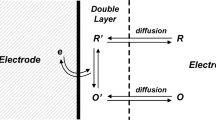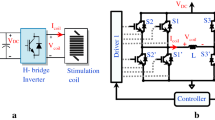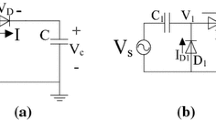Abstract
An energy efficient multichannel adiabatic switching based stimulator with high driving current capability (up to 10 mA) is presented in this paper. The high output current is needed especially for deep brain stimulation system. The stored energy in the electrode-tissue capacitor in the first phase of stimulation will be mostly recovered in the second phase. The proposed stimulator consists of a dynamic differential power supply which makes the biphasic stimulation possible without the need of H-bridge or midrail power supply in the output stage. The stimulation current is directly sensed and controlled by a current-controlled loop which makes the stimulation safe and flexible. In the proposed design, the simultaneous multichannel stimulation with independent electrode-tissue characteristics is possible by making use of the proposed simple digital control scheme. This feature is attained without the need of duplicating the inductors for each channel. A self-voltage-boosting bootstrap circuit is also introduced in order to drive the power MOSFETS of the power supply efficiently. The stimulator is simulated in a 0.18 µ, 32 V HV-CMOS technology for evaluating the effectiveness of the system. The simulation results show up to 1.5–2X efficiency improvement compared to the conventional constant current stimulators with adaptive power supply and around 5–10% efficiency improvement relative to the most recent state-of-the-art switching stimulators.






















Similar content being viewed by others
Change history
12 May 2018
The original version of the article unfortunately contained an error in figure. The actual size of Fig. 11 in the published paper did not appear completely. The complete view of Fig. 11 is shown in this erratum.
References
Perlmutter, J. S., & Mink, J. W. (2006). Deep brain stimulation. Annual Review of Neuroscience, 29, 229–257.
Wilson, B. S., et al. (1991). Better speech recognition with cochlear implants. Nature, 352(6332), 236–238.
Lin, C.-Y., Li, Y.-J., & Ker, M.-D. (2014). Design of high-voltage-tolerant stimulus driver with adaptive loading consideration to suppress epileptic seizure in a 0.18-m CMOS process. Analog Integrated Circuits and Signal Processing, 79(2), 219–226.
Oluigbo, C. O., Salma, A., & Rezai, A. R. (2012). Deep brain stimulation for neurological disorders. IEEE Reviews in Biomedical Engineering, 5, 88–99.
Kuncel, A. M., & Grill, W. M. (2004). Selection of stimulus parameters for deep brain stimulation. Clinical Neurophysiology, 115(11), 2431–2441.
Lyons, M. K. (2011). Deep brain stimulation: Current and future clinical applications. Mayo Clinic Proceedings, 86(7), 662–672.
Moore, S. K. (2006). Psychiatry’s shocking new tools. IEEE Spectrum, 43(3), 24–31.
Livi, P., Heer, F., Frey, U., Bakkum, D. J., & Hierlemann, A. (2010). Compact voltage and current stimulation buffer for high-density microelectrode arrays. IEEE Transactions on Biomedical Circuits and Systems, 4(6), 372–378.
Lee, J., Rhew, H.-G., Kipke, D., & Flynn, M. (2010). A 64 channel programmable closed-loop neurostimulator with 8 channel neural amplifier and logarithmic ADC. IEEE Journal of Solid-State Circuits, 45(9), 1935–1945.
Lee, H.-M., Park, H., & Ghovanloo, M. (2013). A power-efficient wireless system with adaptive supply control for deep brain stimulation. IEEE Journal of Solid-State Circuits, 48(9), 2203–2216.
Testerman, R. L., Rise, M. T., & Stypulkowski, P. H. (2006). Electrical stimulation as therapy for neurological disorders. IEEE Engineering in Medicine and Biology Magazine, 25(5), 74–78.
Simpson, J., & Ghovanloo, M. (2007). An experimental study of voltage, current, and charge controlled stimulation front-end circuitry. In Proceeding of IEEE international symposium circuits and systems, New Orleans, LA (pp. 325–328).
Mooziraji, F. B., & Shoaei, O. (2016). A high power efficient multi-waveform current stimulator used in implantable neural stimulation. Analog Integrated Circuits and Signal Processing, 86(3), 459–469.
Kelly, S. K., & Wyatt, J. L. (2011). A power-efficient neural tissue stimulator with energy recovery. IEEE Transactions on Biomedical Circuits and Systems, 5(1), 20–29.
Arfin, S. K., & Sarpeshkar, R. (2012). An energy-efficient, adiabatic electrode stimulator with inductive energy recycling and feedback current regulation. IEEE Transactions on Biomedical Circuits and Systems, 6(1), 1–14.
van Dongen, M. N., & Serdijn, W. A. (2013). A switched-mode multichannel neural stimulator with a minimum number of external components. In 2013 IEEE international symposium on circuits and systems (ISCAS). IEEE.
van Dongen, M. N., & Serdijn, W. A. (2016). A power-efficient multichannel neural stimulator using high-frequency pulsed excitation from an unfiltered dynamic supply. IEEE Transactions on Biomedical Circuits and Systems, 10(1), 61–71.
Randles, J. E. B. (1947). Kinetics of rapid electrode reactions. Discussions of the Faraday Society, 1, 11–19.
Noorsal, E., Sooksood, K., Xu, H., Hornig, R., Becker, J., & Ortmanns, M. (2012). A neural stimulator frontend with high-voltage compliance and programmable pulse shape for epiretinal implants. IEEE Journal of Solid State Circuits, 47(1), 244–256.
Cheung, T., Nu, M., Hoffman, M., Katz, M., Kilbane, C., Alterman, R., et al. (2013). Longitudinal impedance variability in patients with chronically implanted DBS devices. Brain Stimulation, 6, 746–751.
Chen, Y.-J., et al. (2012). A novel constant on-time current-mode control scheme to achieve adaptive voltage positioning for DC power converters. In: IECon 2012-38th annual conference on IEEE industrial electronics society. IEEE.
Bari, S., Li, Q., & Lee, F.C. (2018). A new fast adaptive on-time control for transient response improvement in constant on-time control. IEEE Transactions on Power Electronics, 33(3), 2680–2689.
Nien, C.-F., et al. (2017). A novel adaptive quasi-constant on-time current-mode buck converter. IEEE Transactions on Power Electronics, 32(10), 8124–8133.
Williams, I., & Constandinou, T. (2013). An energy-efficient, dynamic voltage scaling neural stimulator for a proprioceptive prosthesis. IEEE Transactions on Biomedical Circuits and Systems, 7(2), 129–139.
Dessouky, M., & Kaiser, A. (1999). Input switch configuration suitable for rail-to-rail operation of switched op amp circuits. Electronics Letters, 35(1), 8–10.
Manuals.medtronic.com. (2018). Available at: http://manuals.medtronic.com/content/dam/emanuals/neuro/CONTRIB_236317.pdf. Accessed 2 Dec 2017.
Author information
Authors and Affiliations
Corresponding author
Rights and permissions
About this article
Cite this article
Shirafkan, R., Shoaei, O. A power efficient, differential multichannel adiabatic electrode stimulator for deep brain stimulation. Analog Integr Circ Sig Process 95, 481–497 (2018). https://doi.org/10.1007/s10470-018-1171-z
Received:
Revised:
Accepted:
Published:
Issue Date:
DOI: https://doi.org/10.1007/s10470-018-1171-z




